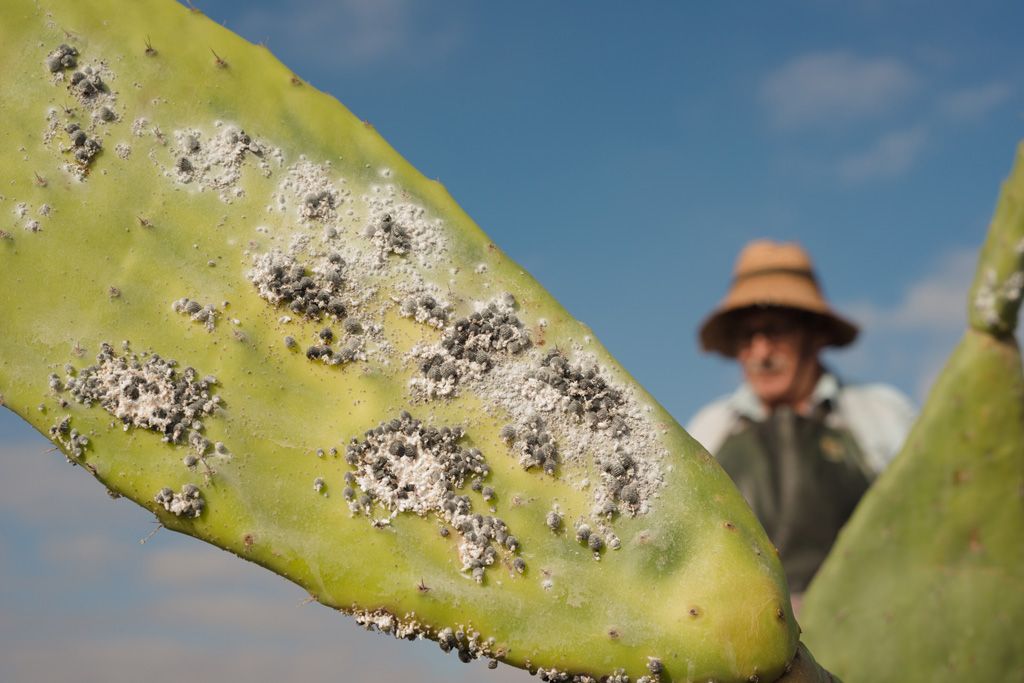Local Storage seems to be disabled in your browser.
For the best experience on our site, be sure to turn on Local Storage in your browser.
La Cochinilla, Lanzarote culture

What is Cochinilla?
If you live or have visited Lanzarote, you may have heard of the cochineal but... Would you tell me what it is?
The cochineal is an insect that parasitizes the Opuntia Ficus Indica cactus, or more commonly known as tunera.
The scientific name of the cochineal is Dactylopius coccus, the most outstanding anatomical distinction of this family of insects is the long beak or face that all its species possess.
Thanks to this beak they manage to absorb the juice of the plant, being this its only and exclusive food.
The origin of the name Cochinilla seems to be found in the Latin 'coccinus', whose meaning is 'red'. Another possibility of origin of the name could be based on the humid cochineal, that small insect that is usually found under the stones of the field, which rolls up forming a little ball when we try to catch it.
The cochineal is characterized by its pronounced sexual dimorphism. While the female, about 5 to 6 mm long and leaden grey in colour, has a chubby shape and no wings, the male, on the other hand, has the appearance of a normal insect in which the head, the thorax with its wings and the abdomen are clearly perceived, as if it were a small milky white fly.
Such is the difference in shape between the female and the male that we might believe when we see them as two insects of different species.
But the most striking and surprising anatomical character of this insect in the male sex is undoubtedly the absence of buccal organs with which to feed having lost them by atrophy during the process of metamorphosis that suffers when passing from the state of nymph to adult.
The young in their first phase of nymphs, both males and females, are not easy to recognize with the naked eye due to their extreme smallness.
From birth, the cochineal contains the characteristic crimson liquid that has made the insect so famous and from which the dyeing industry has benefited so much.
Its life cycle
Shortly after birth, the ''babies'' leave the protection of the mother's body and move over the cactus in search of a place to stick their beak or face. Once they find their ideal place, they are definitively installed, to such an extent that if for any reason they detach from the plant they can no longer grasp it again and die without remission.
From then on, the insect lives motionless clinging to the plant, generally forming more or less compact and irregular groups of a good number of individuals, sometimes piled on top of each other, when not in small groups of a few individuals, and even specimens can be seen alone or isolated from the others scattered on the cactus.
A curious characteristic of this female insect is that, once installed on the cactus, it secretes a kind of white powder with a floury aspect with which it is covered.
The time it takes the female to reach adulthood ranges between two and three and a half months, influencing this development the prevailing ambient temperature, accelerating such a process with summer heat. On the other hand, the young that become males do it a month and a half or two months of age, producing then the curious fact that they lose by atrophy their buccal organs and die of starvation to few days, using that scarce time of life that they have left, in fertilizing the females.
Once the winter is over, the cold begins to subside and the mealybug reactivates its reproduction, reaching the maximum in this activity during the warm summer months as long as the temperature is not excessive. However, in winter, if it is not too cold and if it does not rain too violently, it does not stop its procreative activity, although it is visibly slowed down.
It is generally oviparous, but in extreme situations can use another form of reproduction, somewhat exceptional in biology, which occurs with some frequency in these small beings, is the so-called parthenogenesis (from the Greek parthenos, 'virgin', and genesis, 'generation'), consisting of a female can have offspring without the intervention of the male.
Description of the tunera in which the cochineal lives.
The cochineal can live on different species of the genus Opuntia, of the family of cactus, but the one that offers better conditions as host plant for this insect is the one that is cultivated in Lanzarote with this purpose, although only in its variety of white fruit, the Opuntia ficus-indica, previously called O. ficus-barbarica and more recently with the synonym O. maxima.
This plant receives the name tunera in Lanzarote, prickly pear in the Peninsula and nopal in America, is unmistakable to the eye for its characteristics shovels or pencas up to more than half a meter in length in the form of a racket.
As a curious fact we can say that the leaves of the tuneras are not the pencas, but the thorns.
The tuneras, besides reproducing in a normal way by means of seeds, that are pollinated by numerous insects and scattered later by diverse animals when eating their fruits -birds of different species, lizards and rodents- can also reproduce perfectly in a natural way by means of the shovels or pencas when these are partially buried after falling to the ground when detaching from the plant.
The fields of tuneras dedicated to the breeding of the cochineal on the island are called ‘’huertas’’, or more specifically ‘’cercados’’ when they are surrounded by a dry stone wall.
The harvest of Cochinilla has been very important for the residents of Lanzarote especially in the areas of Mala and Guatiza.
If you are interested in this insect and want to learn more about it or how is the transformation to turn it into the natural dye that we all now know as E-120, do not hesitate to visit the Museum and Interpretation Center and Transformation of La Cochinilla en Mala.
Photo: Rubén Acosta
Sources:
González Lemus, Nicolás: “La explotación de la cochinilla en las Canarias del siglo XIX”. Arquipélago-Historia (2001),
Agustín Pallarés Padilla (Charla en el Centro Científico Cultural Blas Cabrera Felipe de Arrecife el 27-I-2003).

